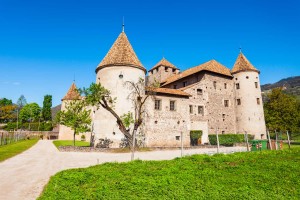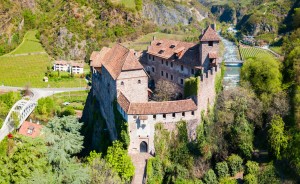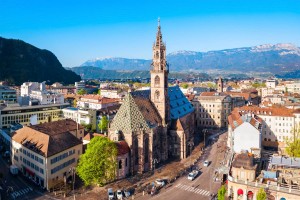South Tyrol’s capital is widely regarded as a distinct highlight among winter tourists and spa guests. Several language and culture groups come together in Bolzano, a place with an everything but harmonious history. Bolzano’s unique role as a city of arts is frequently forgotten. Astonishing and important art treasures plus Europe’s highest density of castles amaze in many different ways. And those are just two of many aspects that make Bolzano a popular holiday destination. Join us on a look behind the scenes.
A late bloomer among different culture groups

©Bigstock.com/saiko3p
Unlike many other Italian cities, Bolzano was mostly meaningless in Roman times and during the Migration Period due to its swamps and frequent flooding, aside from the odd tiny settlement here and there, and a Roman military station. However, numerous castles were built in the Bolzano basin in the Middle Ages. Today’s city was originally conceived as a planned market settlement between 1170 and 1180 established around a market square with alleys lined with arbours. Attested municipal law only came about in 1437.
The former fair city lost more and more significance until the second half of the 19th century when tourism was discovered and developed into a leading industry. A monument of the famous medieval poet Walther von der Vogelweide from the year 1889 signified the transition between German and Italian language area. Dr. Julius Perathoner’s election to mayor in 1895 kicked off a highly active period that saw the city museum, theatre, bridges, schools, promenades, and tramlines built and/or extended. Numerous industrial plants were established during the Italianisation programme; the fascist regime redesigned the cityscape from 1928 onward. Certain tensions between Bolzano’s different language and culture groups remain to this day, but there’s certainly a much better understanding now in a variety of ways.
Castles and estates

©Bigstock.com/saiko3p
The Bolzano basin has the highest density of castles in Europe with around 40 fortresses within a small area, built by nobility on predominantly exposed spots from the 12th century onward. Numerous prestigious castles and estates in and around Bolzano can still be visited. Don’t miss out on the following favourites:
- Runkelstein Castle: Experience Bolzano’s history up close on uneven ground. The publicly accessible Runkelstein Castle likely dates back to around 1237. It was destroyed and rebuilt several times in later periods. The main focus is the medieval cycle of frescoes originating between 1388 to 1410. It depicts biblical scenes as well as literary and courtly motifs of its time. The Runkelstein frescoes are one of the most important sources for the history of clothing of the late Middle Ages.
- Maretsch Castle: This 13th century lowland castle rises east of the Talfer Promenade. However, today’s look only developed around 300 years later when a full castle complex extension saw the addition of four round towers and Renaissance frescoes. Maretsch Castle mainly serves as a seminar centre today and can be viewed on enquiry.
- Castel Flavon: The Haselburg, whose name comes from the Bolzano district Haslach (Aslago), built this castle in the 13th Heavily converted in later years as well, a severe fire turned a lot of the facility into ruins during the 18th and 19th century. Today’s congress centre with an inn is particularly known for its evocative Renaissance frescoes.
- Ansitz Compil: This glorious building is one of many estates in Bolzano known by their German term “Ansitz”. This listed estate was first mentioned in the 13th century as property of the Reifer von Compil. It got today’s look around 1870 after a British neo-Gothic conversion.
Bolzano’s churches

©Bigstock.com/saiko3o
Bolzano isn’t just home to countless castles, fortresses and estates, there are also a plethora of churches with amazing architectural variety ranging from the Middle Ages to the 20th century. We really recommend the following churches with their unique art treasures:
- Maria Himmelfahrt: The origins of the cathedral and the bishop’s see date back to a Romanesque parish church that was built in 1180. A late Gothic new building was added around 1300 when Bolzano grew. The Leitacher Törl with its sculptures, the tower and the chapter of the collegiate church followed in later years. Various late Gothic frescoes and the neo-Gothic side altars plus an International Gothic pietà line the cathedral’s inside. The particularly venerated, historic Sacred Heart painting by Johann Josef Karl Henrici is also kept in Maria Himmelfahrt.
- Old Parish Church of Gries: The Catholic Our Lady’s Church in the district Gries-Quirein lost its parish church status to the new collegiate church. It is now a listed building due to its precious art treasures. The Romanesque crucifix designed just after 1200 and the incomplete, late Gothic carved altar by Michael Pacher are of special significance.
- Chiesa dei Domenicani: This church with its former monastery carries high art-historic significance as well. Its apse is one of the oldest examples of Gothic sacred architecture in Tyrol. Impressive Gothic wall paintings and an astonishing baroque altarpiece by Guercino in the nave lead through numerous different centuries of art history.
- Convento dei Francescani: Three large, post-war glass windows rise in the apse. They are the most modern part of this cloister complex with a chapel where a young Francis of Assisi supposedly served at the altar during a mass and rung the bell. A splendid carved altar and significant frescoes in the cloister lead through art and church history spanning 800 years.
Even more buildings and museums
Let’s take one step back before we fully immerse ourselves in the sacred marvels of Bolzano and give you a glimpse of some of the more modern buildings and monuments:
- South Tyrol Museum of Archaeology: Ötzi the Iceman “lives” in Bolzano’s Museum Road. The world-famous glacial mummy belongs to the collection of one of Italy’s most important archaeological museums. Gripping insights into the early history of the Southern Alps are mainly dedicated to finds between the Old Stone Age and the Migration Period.
- Museion: A peculiar cube (54 m long, 25 m high) rises at the end of a bridge with swinging bends. The museum for modern and contemporary art has been in this highly fascinating building – a tremendous sight in its own right – since 2008.
- Monumento alla Vittoria: Fascism pushed forward involuntary Italianisation in South Tyrol, especially in Bolzano. This huge monument was built instead of a memorial for those who had fallen in the First World War. It should come as little surprise that the Victory Monument was a topic of hot debate for many decades. A permanent exhibition of Bolzano’s and South Tyrol’s history during fascism was established in the underground rooms in 2014.
- Casa Littoria: Similar to the Victory Monument, the former seat of the Italian Fascist Party was turned into a memorial. Numerous explanatory boards provide information on the historic background, the reliefs, and the names of the engraved, now forbidden fascist organisation. Casa Littoria is currently used as an administrative building.
- Messner Mountain Museum Firmian: Six sites in the Italian provinces South Tyrol and Belluno form the mountain museum of the world-renowned extreme climber Reinhold Messner. The museum project Firmian in Bolzano has found a home in the late medieval Sigmundskron Castle. Among the cornerstones of the MGM exhibition is the relationship between alpinism, tourism, man and nature as illustrated through numerous pictures, sculptures and memorabilia.
It is hard not to fall under the spell of Bolzano. Despite its comparatively brief history, this truly is a city of arts. From the high density of castles to the art treasures in the churches to the open handling of the more recent, dark history – Bolzano is always worth the journey.